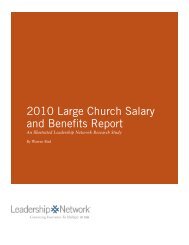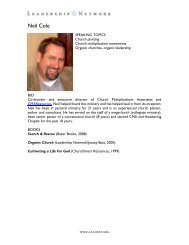ARE WE A PEOPLE AT HALF TIME? - Leadership Network
ARE WE A PEOPLE AT HALF TIME? - Leadership Network
ARE WE A PEOPLE AT HALF TIME? - Leadership Network
Create successful ePaper yourself
Turn your PDF publications into a flip-book with our unique Google optimized e-Paper software.
Curious things happen when you connect<br />
all to all. Mathematicians have proven that<br />
the sum of a network increases as the<br />
square of the number of members. In other<br />
words, as the number of nodes in a<br />
network increases arithmetically, the value<br />
of the network increases exponentially.<br />
Adding a few more members can dramatically<br />
increase the value for all members.<br />
Consider the first modern fax machine that<br />
rolled off the conveyor belt around 1965.<br />
Despite millions of dollars spent on its<br />
R&D, it was worth nothing. Zero. The<br />
second fax machine to roll off immediately<br />
made the first one worth something. There<br />
was someone to fax to. Because fax<br />
machines are linked into a network, each<br />
additional fax machine sliding down the<br />
chute increases the value of all the fax<br />
machines operating before it.<br />
The fax effect suggests that the more<br />
plentiful things become, the more valuable<br />
they become. In a <strong>Network</strong> Economy,<br />
value is derived from plenitude, just as fax<br />
machine’s value increases in ubiquity.<br />
Power comes from abundance. Copies<br />
(even physical copies) are cheap.<br />
Therefore, let them proliferate.<br />
Instead, what is valuable is the scattered<br />
relationships—sparked by the copies—<br />
that become tangled up in the network<br />
itself.<br />
In the <strong>Network</strong> Economy, scarcity is<br />
overwhelmed by shrinking marginal costs.<br />
Where the expense of churning out another<br />
copy becomes trivial (and this is happening<br />
in more than software), the value of<br />
standards and the network booms.<br />
In the <strong>Network</strong> Economy, more gives<br />
more.<br />
3. The Law of Exponential Value<br />
Success is nonlinear<br />
A chart of Microsoft’s cornucopia of profits<br />
is a revealing graph. During its first 10<br />
years, Microsoft’s profits were negligible.<br />
Its profits rose above the background noise<br />
only around 1985. But once they began to<br />
rise, they exploded.<br />
The penetration of fax machines likewise<br />
follows a tale of a 20 year overnight<br />
success. Two decades of<br />
marginal success, then during the mid-<br />
1980’s, the number of fax machines quietly<br />
crosses the point of no return-and the<br />
next thing you know, they are irreversibly<br />
everywhere.<br />
Each of these curves is a classic template<br />
of exponential growth, compounding in a<br />
nonlinear way. Biologists know about<br />
exponential growth; such curves are<br />
almost the definition of a biological<br />
system. That’s one reason the <strong>Network</strong><br />
Economy is often described more accurately<br />
in biological terms. In<br />
deed, if the Web feels like a<br />
frontier, its because for the first<br />
time in history, we are witnessi<br />
n g<br />
biological growth in technological<br />
systems.<br />
At the same time, each of the<br />
above examples is a classic<br />
model of the <strong>Network</strong><br />
Economy. The compounded<br />
successes of Microsoft and the<br />
fax machine hinge on the prime<br />
law of networks: value<br />
explodes exponentially with<br />
membership.<br />
In the <strong>Network</strong> Economy, success<br />
is nonlinear.<br />
4. The Law of Tipping Points<br />
Significance precedes<br />
momentum<br />
There is yet one more lesson to<br />
take from these primeval cases<br />
of the <strong>Network</strong> Economy. And here, another<br />
biological insight will be handy.<br />
In epidemiology, the point at which a<br />
disease has infected enough hosts that the<br />
infection moves from local illness to a<br />
raging epidemic can be thought of as the<br />
tipping point. The contagion’s momentum<br />
has tipped from pushing uphill against all<br />
the odds to rolling downhill with all the<br />
odds behind it. In biology, the tipping<br />
points of fatal diseases are fairly high, but<br />
in technology, they seem to trigger at much<br />
lower percentages of victims or members.<br />
There has always been a tipping point in<br />
7<br />
any business, industrial or network, after<br />
which success feeds upon itself. However,<br />
the fixed low costs, insignificant marginal<br />
costs, and rapid distribution that we find in<br />
the <strong>Network</strong> Economy depress the<br />
tipping points below the levels of industrial<br />
times; it is as if the new bugs are more<br />
contagious—and more potent.<br />
Lower tipping points, in turn, mean that<br />
the threshold of significance—the period<br />
before the tipping point during which a<br />
movement, growth, or innovation must be<br />
taken seriously—is also dramatically<br />
lower than it was in the industrial age.<br />
Detecting events while they are beneath<br />
this threshold is essential.<br />
In the past, an innovation’s momentum<br />
indicated significance. Now, in the<br />
network environment, significance precedes<br />
momentum.<br />
Biologists tell a parable of the lily leaf,<br />
which doubles in size every day. The day<br />
before it completely covers the pond, the<br />
water is only half covered, and the day<br />
before that, only a quarter covered, and the<br />
day before that, only a measly eighth. So,<br />
while the lily grows imperceptibly all<br />
continued on page 8







